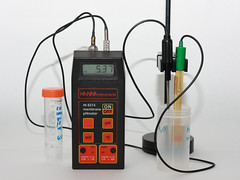What to Measure?
Now, how would you measure the rate of photosynthesis?
Again, let's look at the equation for photosynthesis:
CO2 + H2O + light --> O2 + glucose
There are 2 things we can quickly measure in this experiment (the dependent variables): amount of oxygen produced, or, amount of carbon dioxide used.
If the rate of photosynthesis increases, the rate of oxygen production goes up, and the rate of CO2 consumption rises too! If the rate of photosynthesis goes down, then we can expect the opposite effect: oxygen production drops and carbon dioxide is not used as quickly.
But how can we measure oxygen or carbon dioxide levels?
It's quite easy with Elodea!
Measuring Oxygen
In water, oxygen that is produced by the Elodea cutting is released as bubbles from its leaves. The rate of oxygen produced can be measured by either counting the number of bubbles released in a certain amount of time (bubbles/min), or by trapping the oxygen gas in an inverted syringe or tube and measuring the volume of oxygen produced in a certain amount of time (cm3/min).
It's important that you give the plant a few minutes to photosynthesize before starting your measurements. This ensures that the plant is making oxygen at a constant rate. (You should also check this visually, before starting to count the bubbles). To have more accurate results, take the measurement at least 3 times. You could also vary the amount of time used to count the bubbles (10 seconds, 30 seconds, 1 minute). Then calculate the number of bubbles per minute or per second.
Measuring Carbon Dioxide
To measure carbon dioxide levels, we can measure the pH of the water. This is because when carbon dioxide dissolves in water, it forms carbonic acid and lowers the water pH. Therefore, in the opposite situation -- i.e. when carbon dioxide is used -- the pH goes up.
CO2 + H2O --> H2CO3 <--> H+ + HCO3-
 |
| pH probe by Sergei Golyshev (http://www.flickr.com/photos/29225114@N08/) |
As the changes in pH are probably quite small, it would be necessary to use a pH meter (or pH probe) with a digital readout. pH paper may not be sensitive enough to detect the changes. Measure the pH once before starting the experiment. Then, start taking pH measurements after the plant is consistently producing oxygen bubbles. Take a few measurements at 5 minute intervals (for example, you can run the experiment for 15 minutes and that would give you 3 readings).
Remember to rinse the pH probe with distilled water before transferring it to your test tube. You should also make sure that the test tube water is well-mixed before taking your measurement, by stirring with a glass rod, or inverting the tube a few times (make sure you use a rubber stopper so you don't spill it all!).
Another important note: make sure you use really clean test tubes, plants and stoppers! Any contaminants could affect your pH reading. Rinse everything with tap water before you start your experiment!
Read more about setting up your experiment, and what you should expect and look out for.
